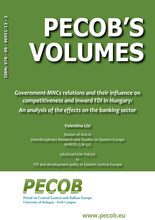and Balkan Europe
by IECOB & AIS Università di Bologna

This area collects and offers a wide range of scientific contributions and provides scholars, researchers and specialists with publishing opportunities for their research results
Government-MNCs relations and their influence on competitiveness and inward FDI in Hungary: An analysis of the effects on the banking sector
by: Valentina Lisi
ISBN: 978-88-96951-13-2

Abstract
Ever since the beginning of the transition period from a state-planned to a market-oriented economy, Hungary has been a frontrunner in attracting FDI in the Eastern Central European region. Despite the common tendency among the governments in power to apply an open-door strategy towards foreign investors in the country, the government led by Viktor Orbán from 2010 to 2014 has diverted this approach. Backed by strong support in the public opinion on a national level, he has made of the rhetoric against multinational companies (MNCs) one of the main points of its political campaign, as proved by the “unorthodox” measures implemented in 2010 towards the most foreign-denominated sectors of the Hungarian economy. However, given the high dependence on MNCs already settled in the country in terms of exports, employment and innovation, as well as the surge in the inflow of FDI registered in 2012, the present research aims to understand to what extent the rhetoric against multinationals has been actually applied in the timeframe 2010-2014. In order to do so, the present work pinpoints the measures implemented influencing foreign investment (incoming and already established) in the country and investigates the many ways through which the government’s activity has affected the competitiveness of the country on an international level. The case study carried out focuses on the main causes of distress of the Hungarian banking sector, extensively targeted by the political authorities. These include banks poor performances in terms of profitability also in a regional comparison, the stubbornness of the punitive measures implemented by the government, as well as the Fidesz agenda related to the attempt to reduce drastically foreign ownership in the sector.
Methodology employed
The methodology used includes content analysis of both primary and secondary sources, meaning documents, statistics, books, papers and reports. In dealing with particular contemporary issues newspapers were also referred to as a source. In addition, five interviews were carried out (personally or by emails) at the Hungarian Investment and Trade Agency (HITA), at the Italian Trade Agency in Budapest, with Hungarian researchers, as well as with an Unicredit’s economic analyst. The information regarding the Hungarian banking sector is provided mainly by the Central Bank of Hungary (MNB), the Hungarian Banking Association and the research centers of the major banking groups active in the country and in the region such as OTP, Unicredit, Raiffeisen and Intesa Sanpaolo.
Main outcomes achieved
The results of the research showed how the political and administrative aspects of the governmental activity have influenced negatively Hungarian competitiveness due to policy instability and poor institutional quality. From the economic point of view, however, the improving macroeconomic results, the low direct taxation and business legislation are positively influencing the location advantage of the country. The stunning results in the attraction of FDI, however, proved to be related to data distortion due to the consistent presence of capital in transit and capital injections in the banking sector.
Government-MNCs relations in the country turned out to be less conflicting than what has been publicly advertised by the cabinet and the media. They can be rather described as selective on the basis of the activities carried out by MNCs, their dimensions and the sectors involved. Nonetheless, this is not the case of the banking sector, which levels of profitability have been consistently affected by the unfavourable taxation and the punitive measures implemented in relation to the issue of the repayment of foreign currency loans.
Table of contents
Acknowledgements
Introduction
Chapter 1. The influence of the government on the international competitiveness of Nations
1.1. The International Competitiveness of Nations
1.1.1. Definition of the concept
1.1.2. Determinants of a country’s location attractiveness
1.2. How political institutions attract FDI
1.2.1. Government related factors of attractiveness
1.2.2. Investment promotion policies
1.3. Multinational Banking and government regulation
Chapter 2. The Hungarian international competitiveness and economic performances
2.1 Macroeconomic outlook
2.1.1. GDP growth
2.1.2. The current account
2.1.3 MNB’s monetary policy
2.1.4. The labour market
2.2. An analysis of Hungarian competitiveness: points of strength and weaknesses
2.3. The Hungarian “original sin”: the high reliance on external sources of financing
2.3.1. General outlook of the Hungarian external debt conditions
2.3.2. Hungarian reliance on external funding from the 70s until today
2.3.3. Hungarian macroeconomic capital structure: foreign indebtedness and inward FDI flows as two sides of the same coin
2.4. Inward FDI in Hungary: key facts
2.4.1. Developments in FDI inflows
2.4.2. FDI breakdown by sector and country of origin
Chapter 3. Business-government relations: Viktor Orbán’s economic policies towards foreign investors
3.1 Introduction: the rhetoric against multinationals
3.2. Orbán’s business legislation and fiscal policy
3.2.1. The case of the windfall taxes
3.3. Investment promotion policies: nature and effectiveness
3.3.1. Historical changes in investment promotion strategies
3.3.2. Investment promotion policies nowadays
3.4. The Funding for Growth Scheme (FGS)
3.5 Strategic cooperation agreements
3.5.1. The strong commitment to supporting the automotive industry
3.5.2 The Eastern Opening
Chapter 4. Orbán vs banks: an analysis of the Hungarian banking sector’s performances and causes of distress
4.1. Banking sector outlook since the outbreak of the crisis
4.1.1. The market structure
4.1.2. The worrying comparison between Hungarian and peer economies’ banking systems
4.2. Orbán vs banks: fiscal measures and public debate
4.2.1. Fiscal measures against financial institutions
4.2.2. The current political discussion on banks
4.3. The dominance of foreign currencies on banks’ funding and lending activities
4.3.1. Government FX loans’ repayment schemes and programs since 2011
4.4. Was it really worth it?
Conclusions
Bibliography
List of useful websites


 Download the Volume
Download the Volume





